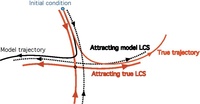
Photo from wikipedia
We provide the maximum number of limit cycles for continuous and discontinuous planar piecewise differential systems formed by linear Hamiltonian saddles and separated either by one or two parallel straight… Click to show full abstract
We provide the maximum number of limit cycles for continuous and discontinuous planar piecewise differential systems formed by linear Hamiltonian saddles and separated either by one or two parallel straight lines. We show that when these piecewise differential systems are either continuous or discontinuous and are separated by one straight line, or are continuous and are separated by two parallel straight lines, they do not have limit cycles. On the other hand, when these systems are discontinuous and separated by two parallel straight lines, we prove that the maximum number of limit cycles that they can have is one and that this maximum is reached by providing an example of such a system with one limit cycle. When the line of discontinuity of the piecewise differential system is formed by one straight line, the symmetry of the problem allows to take this straight line without loss of generality as the line x = 0. Similarly, when the line of discontinuity of the piecewise differential system is formed by two parallel straight lines due to the symmetry of the problem, we can assume without loss of generality that these two straight lines are x = ±1.
Journal Title: Symmetry
Year Published: 2021
Link to full text (if available)
Share on Social Media: Sign Up to like & get
recommendations!